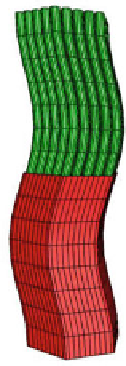Biomedical Engineering Reference
In-Depth Information
3.0
30
Crimp Angle
10
15
20
2.5
20
2.0
1.5
10
1.0
0
0.5
0.00
0.02
0.04
0.06
0.08
0.00
0.02
0.04
0.06
0.08
Strain
Strain
Fig. 10 3D micromechanical models with crimped and helical fiber organization [
187
]. Top left
micromechanical FE model shows fibrils (green) embedded within the matrix (red). Top right
straight, crimped, helical and helically crimped fibril organizations were modeled. Bottom left
crimped models were able to reproduce the classic nonlinear behavior for tendon. Bottom right
crimped models with a constant helical pitch predicted both the nonlinear stress-strain behavior
and the large, nonlinear Poisson's function
macroscale stress-strain response and a homogenized Poisson's function. For a
subset of models, tensile strains of 8 % were applied and the nonlinear stress-
strain response and the Poisson's function were obtained (Fig.
10
, bottom). For all
other models, small strains (0.5 %) were applied and homogenized Poisson's ratios
were obtained.
Models with planar crimp (both with and without a helical twist) could generate
the classic nonlinear response, but only models with a helical twist could generate
large Poisson's ratios (Fig.
10
, bottom). This suggests that helical twisting of
fibrils (which has been observed histologically [
226
,
248
]) may contribute to the
large experimentally measured Poisson's ratios. A parametric study which varied






















































Search WWH ::

Custom Search